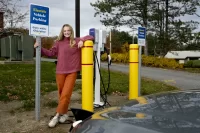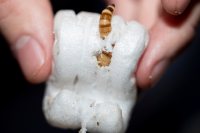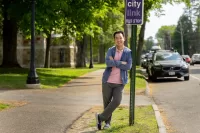
If you’re asking people to behave sustainably and sort their trash as they throw it away, it’s only fair to make their choices as clear as possible.
“Apparently people decide where they’re going to put their trash when they’re about five to 10 feet away from the bins,” says Tom Twist, Bates sustainability manager.
Accordingly, in collaboration with the Bates Communications design team, Twist has come up with a standardized configuration for waste-sorting stations that’s intended to guide people as they unburden themselves of Snickers wrappers, paper napkins, apple cores, Sanpellegrino cans, etc.
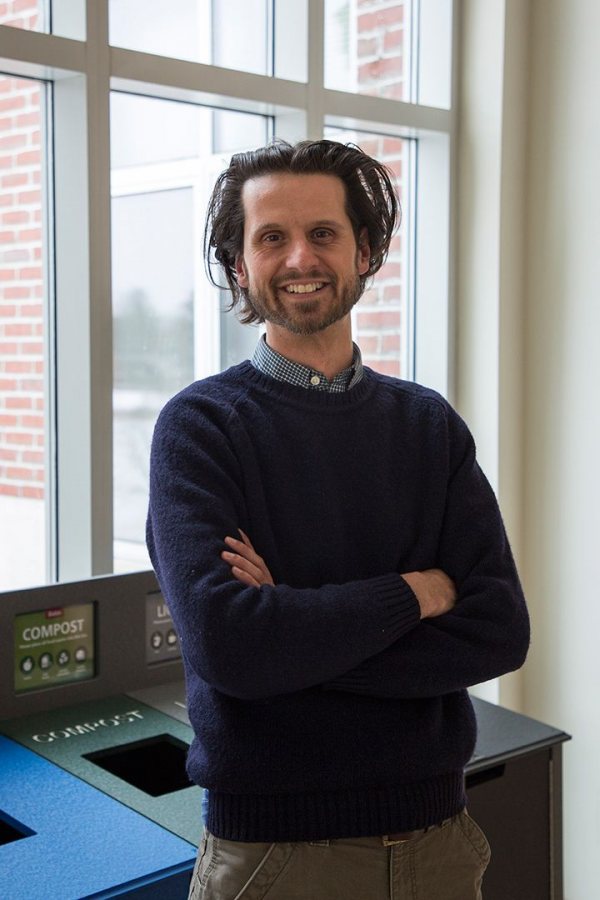
Bates Sustainability Manager Tom Twist poses next to a Pettengill Hall waste-sorting station. (Josh Kuckens/Bates College)
New compartmented bins in about 30 public locations around Bates are color-coded and marked with signage that, Twist says, is “readily visible from afar.” The signage relies on icons, along with text, to indicate what goes where — recyclables, compostables, returnables, fodder for the landfill, etc.
Fabricated from a material made mostly of recycled plastic milk jugs, the bins are custom-built for Bates by a Wisconsin company, Max-R. “I think we have some of the nicest-looking, the most functional bins I’ve ever seen,” Twist says.
The redesign is part of an effort, begun a few years ago under Twist’s predecessor, to get the Bates community to recycle more of its refuse. As a percentage of the overall waste stream, “our recycling rate is 34 percent,” Twist says, while an estimated 75 percent of all refuse is actually recyclable.
“We’re trying to come up with a reasonable goal for the college,” he explains. “We’re kicking around the idea of getting to 50 percent recycling in the next several years.”
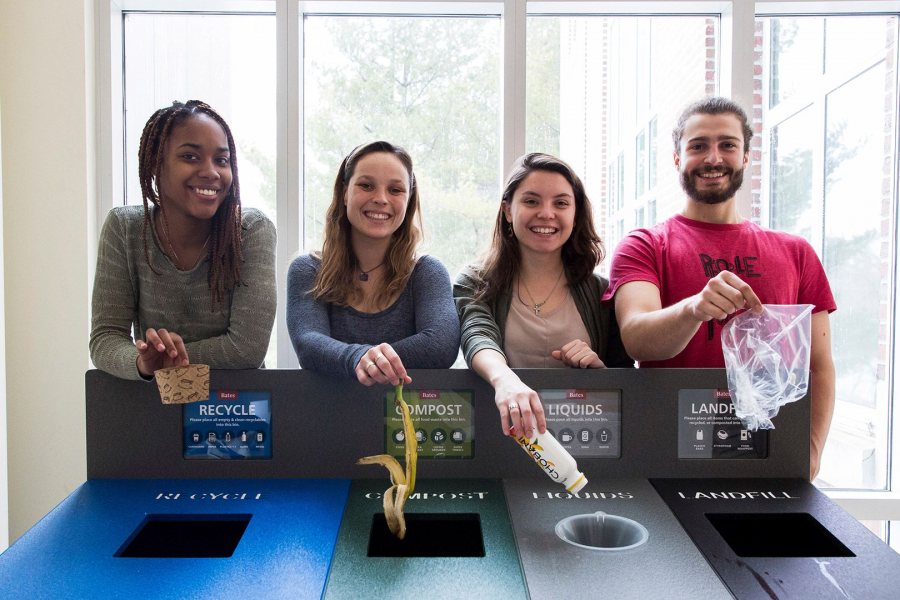
Four Bates EcoReps — Isa Moise ’19 of Mount Vernon, N.Y., Beanie O’Shea ’18 of Somers, Conn., Hannah Slattery ’18 of Gilford, N.H., and George Fiske ’19 of West Hartford, Conn. — show off one of the college’s new waste-sorting stations, in Pettengill Hall. (Josh Kuckens/Bates College)
Recycling is a question of folding green as much as sustainability green, Twist adds. It costs Bates about half as much to dispose of the recyclable portion of its refuse as it does to send non-recyclables to the Lewiston landfill.
In fiscal year 2016, Bates paid about $60–80 for each of the 267 tons of trash that went to the landfill. In contrast, it cost about $35 per ton for the 138 tons of recycling that went to Casella Recycling Service.
“It’s not that people are intentionally not sorting their stuff,” says Olivia LaMarche ’20 of Lynnfield, Mass. She’s involved in the waste-stream program as a Bates EcoRep. “It’s just that they’re really not sure what can be recycled, or they’re not positive whether a bin is for recycling or trash.”
The new system is designed to minimize such uncertainty. Hence the standardized bin colors and icons, and the distilling of the icons for maximum clarity.
“We have thought about everything down to the minutest detail, in terms of social engineering,” says Twist.
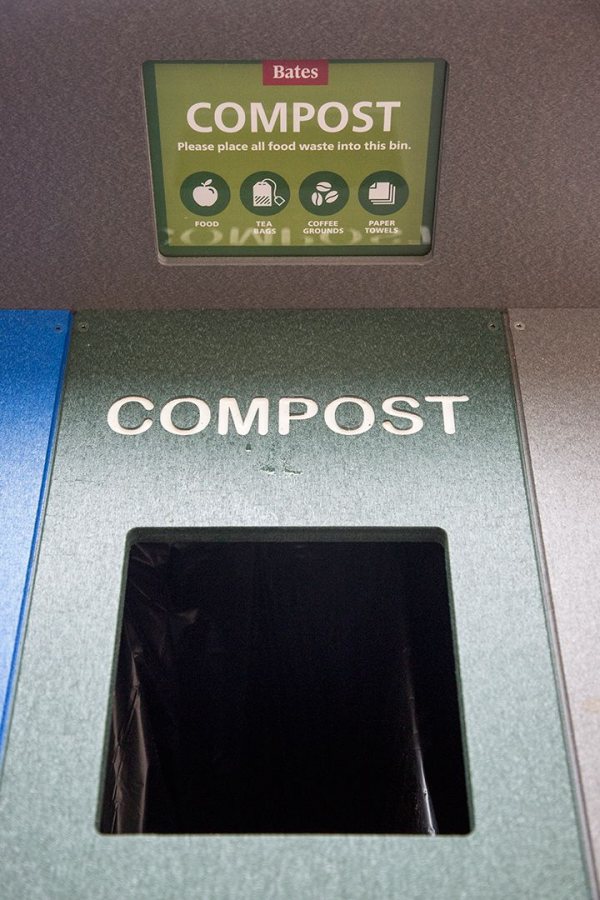
The new waste-receptacle system broadens compost collection beyond Dining Services for the first time at Bates. (Josh Kuckens/Bates College)
For instance, “we intentionally made the recycling compartment of the bins much larger than the trash side, to send a visual cue that you are supposed to be recycling more than you are throwing out.
“We changed the ‘Trash’ sign to ‘Landfill,’ to get people to pause and think.”
One of the most significant changes with the new system is that it captures food waste — and, perhaps surprisingly, paper napkins and paper towels — for composting.
Of course, the tray return line in Commons and a sorting station in the Bobcat Den have diverted food waste from the landfill for years, but food discarded elsewhere on campus did go to the landfill. Now, thanks to the new sorting stations, much of it can be recovered for composting.
Twist explains, “We’re within six miles of southern Maine’s largest industrial composter,” We Compost It!, which has a processing facility in Auburn. That firm has a pickup service that, similar to non-food Bates recycling, ends up costing about half of landfill disposal. (In FY 2016, the college sent 131 tons of material to be composted or fed to pigs at a local farm.)
A disposal station in the Pettengill Hall lobby is, if you will, the flagship of the compost-ready waste-bin fleet. “That was the first location that had compost collection outside of Dining Services,” Twist says. “It was kind of a nerve-wracking thing to start, since it had been tried before and failed.
“There are few things that go south faster than poorly planned food waste collection.”
“There are few things that go south faster than poorly planned food waste collection.”
Another major advance in the new waste-disposal platform is the capacity to separate liquids from the rest of the refuse — and contain them neatly. This is accomplished with bins that have funnels inset into the top that feed watertight containers, which are emptied down the drain.
Segregating liquids is important for a few different reasons. For one thing, paper or plastic that has gotten wet can’t be recycled. In other words, a quarter-full cup of chai dropped into a recycling bin, says LaMarche, “just ruins the recycling.”
Another reason is aesthetic: It’s simply discouraging to the custodians to deal with trash bags leaking old coffee or milk into the refuse bin or across a freshly mopped floor.
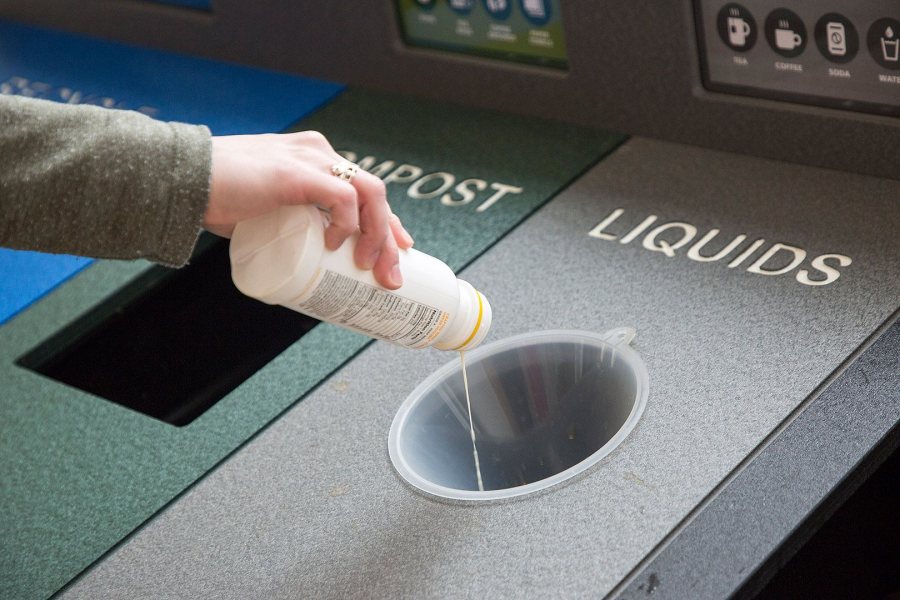
The new waste stations’ liquid-collection system makes life nicer for custodians and helps keep stray liquids from spoiling recyclables. (Josh Kuckens/Bates College)
In fact, says Twist, the new waste-handling system makes life easier in a variety of ways for Bates’ grounds and custodial crews, the folks on the front lines of refuse collection. “A lot of times it’s just been a pain the neck for them. We’re trying to streamline that, to make it really easy.”
For example, the new bins open in the front for changing the bags. That’s an ergonomic improvement over the old bins, which opened at the top, making custodians lift full bags of trash straight up and over the bin.
“We put casters on them so you can roll them from place to place to clean the floor,” Twist adds. And color-coding extends to the trash bags, to ensure that the refuse remains properly sorted after they’ve been removed from the bins.
With the Max-R sorting stations installed only in public spaces on campus, the new system isn’t comprehensive. In the dorms, especially, a variety of sorting facilities still prevails and there’s a ways to go on upping the percentage of recycling.
But the public stations have been working well, says LaMarche, whose contributions to the effort included obtaining grant money to expand compost collection.
She says, “I’ve learned that every person can have an impact. And so just doing what we’re doing, trying to educate students about what happens to waste, where it goes, where to put their waste — every student we reach in some way can actually make a big difference in the long run.”
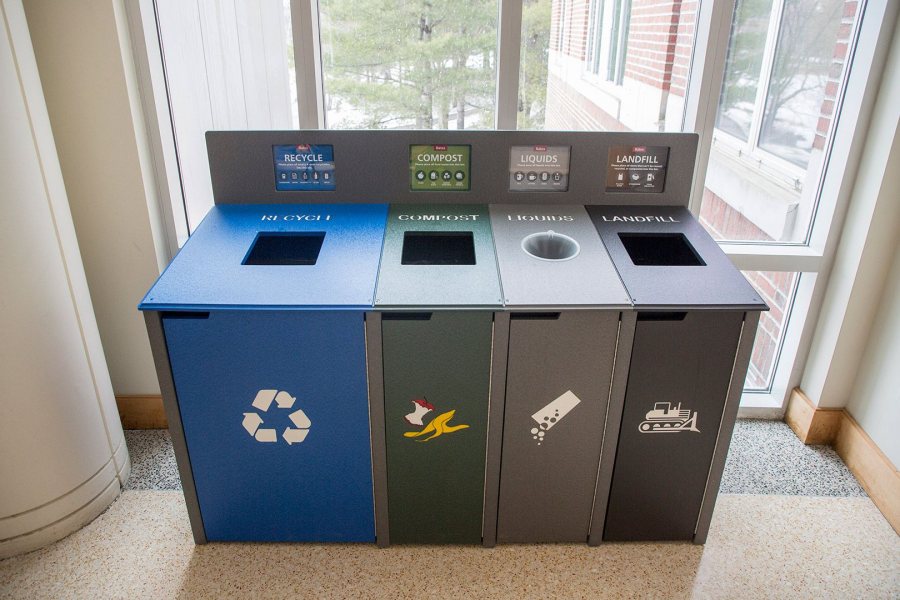
Pettengill Hall, where the waste collection stations made their campus debut, is home to several of them. (Josh Kuckens/Bates College)
